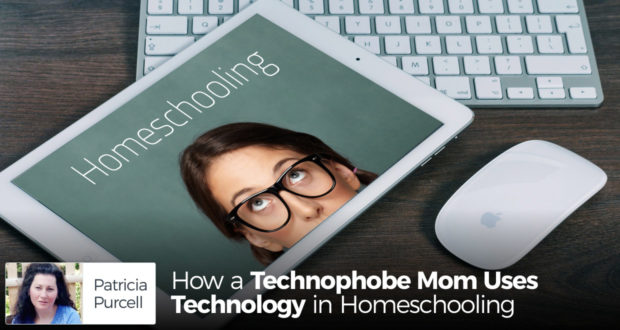Summary
Patricia Purcell doesn’t always ‘get’ technology in homeschool. But it can be valuable, especially with all of today’s options. Here are 6 ways she uses it!I have a confession to make. I am a technophobe.
I don’t mean that I fear to be in the same room with electronics. What I mean is that embracing new technology doesn’t come naturally to me. I don’t look at a gadget and intuitively know how to use it.
In fact, the gadgets that I do have tend to be sorely underused; my kids laugh at me because I like to attach actual sticky notes to my smart phone (I think it’s easier that way).
Don’t get me started on glitches either, because if a device is going to act quirky for anyone…that person would be me.
Despite my rocky relationship with technology, I’ve come to embrace it when it comes to homeschooling. It really does make my life easier, and enables me to get more done. My kids, true children of the twenty-first century, don’t share my gadget issues and eagerly utilize them in their daily work.
In fact, I often turn to them for help with technical issues. So, if you’re like me and are living with a secret fear of technology, here are some ways that I’ve found it to be useful in homeschooling.
1. Communication
Thanks to my laptop and smart phone, I find it easy to keep in touch. Not a day goes by without me checking my online homeschooling groups for news about upcoming activities and plans. My mom friends and I arrange meetings and carpools by text or email without interrupting the flow of our schooldays playing phone tag.
My kids communicate with their own friends primarily through texting and emails. For homeschooled kids, not seeing their friends on a daily basis can potentially be a detriment.
Having an easy means of keeping in touch keeps them close and happy. My daughter’s group of friends emails so often that some of us mothers have had to put time limits on their computer use.
2. Convenience
My older son is enrolled in Seton’s high school program, where the students are assigned a lot of reports. I give thanks every day for our laptops, as they make the writing and revision process so much easier than it was when I was his age pecking away at a typewriter.
Not having to completely retype each essay or research paper makes a big difference in my ability to persuade him to tweak it just a little more before turning it in!
The ability to complete research anytime is another huge bonus of modern technology. Sure we still have stacks of library books piled around, but much research can be done online, whether it’s for a formal report or just a question that needs answering.
Being able to satisfy a child’s curiosity quickly can keep his interest piqued, and often he’ll go on to learn much more about the subject.
Thanks to our library system’s online portal, I can save time by requesting needed books before we go, or even have obscure ones sent from far-flung branches.
This has saved us quite a bit of money, as we use a great many books in our homeschooling!
3. Online Curriculum
The Seton program itself belongs on my list of modern conveniences that help in homeschooling. Although we utilize the books every day, the technology aspect is equally important in enabling our family to manage everything.
Some of the most helpful parts for us include:
- Online lectures. Having my teen engaged in a lecture frees up my time to work with my younger children.
- Uploading work. I hate to wait in line at the post office. Being able to send completed work off to be graded with the click of a button is wonderful! Even better, once the work is graded, the grades are sent to us immediately so we don’t have to wait for the results.
- Testing.
- Counselors. Having help just an email or phone call away is priceless.
4. Computer Programs
There are some excellent packaged courses out there. My family has utilized interactive CD programs for math, Spanish, and typing.
Letting kids use a tablet or computer for their lessons often makes them more willing to work. With instant feedback and the ability to pause and re-listen to instructions, these can be a great option for students to self-learn.
5. Online Supplements
There are many inexpensive (or free) supplemental resources available online. Some of our family’s favorites are:
- Kahn Academy
- Spelling City
- IXL
- Online Mass. This is handy for those times when someone is just too sniffly to attend in person. Without the usual distractions of church (rowdy children), kids can focus more on the Mass too.
6. Recreation
There are some benefits to be had from a bit of downtime spent on a computer. Last year my younger children attended a Scratch camp at our library and became hooked on learning about programming.
With careful monitoring, YouTube can also be quite useful. My daughter has used it to learn the fine points of crochet (she taught herself). My older son uses it to supplement his music lessons, and my youngest enjoys watching videos about how movies and games are made. They can watch the videos over and over again if they need to.
It’s doubtful that we could afford to pay for such lengthy lessons.
Embracing Technology in My Homeschool
While I’m in awe of those who homeschooled successfully decades ago, I would not want to live without the conveniences of today.
Though I’ll likely never be the first in line for the latest trend or gadget, if it can help to streamline my homeschooling I’ll eventually embrace it. After all, I know that if I can’t figure out how to work it, I can just ask my kids!
Are you a technophobe too? Have you come to embrace technology in your homeschooling? I’d love to hear about it (so I know I’m not the only one)!

 Seton Magazine Catholic Homeschool Articles, Advice & Resources
Seton Magazine Catholic Homeschool Articles, Advice & Resources

